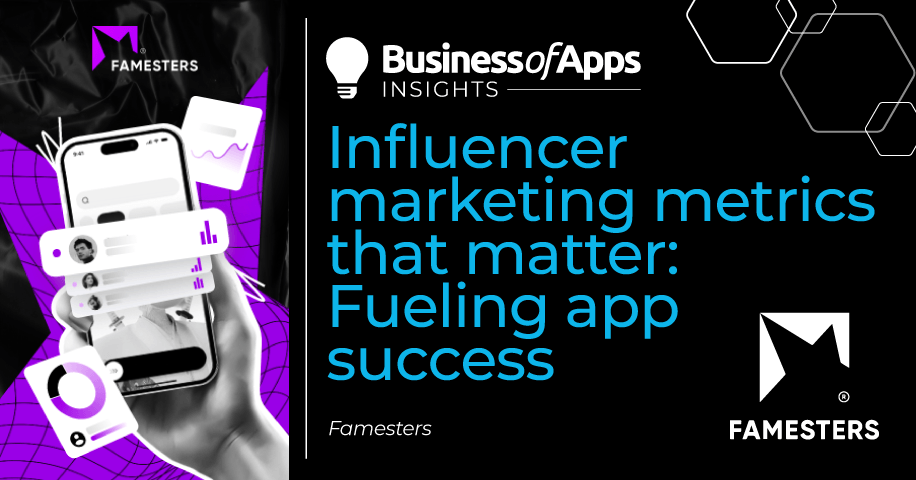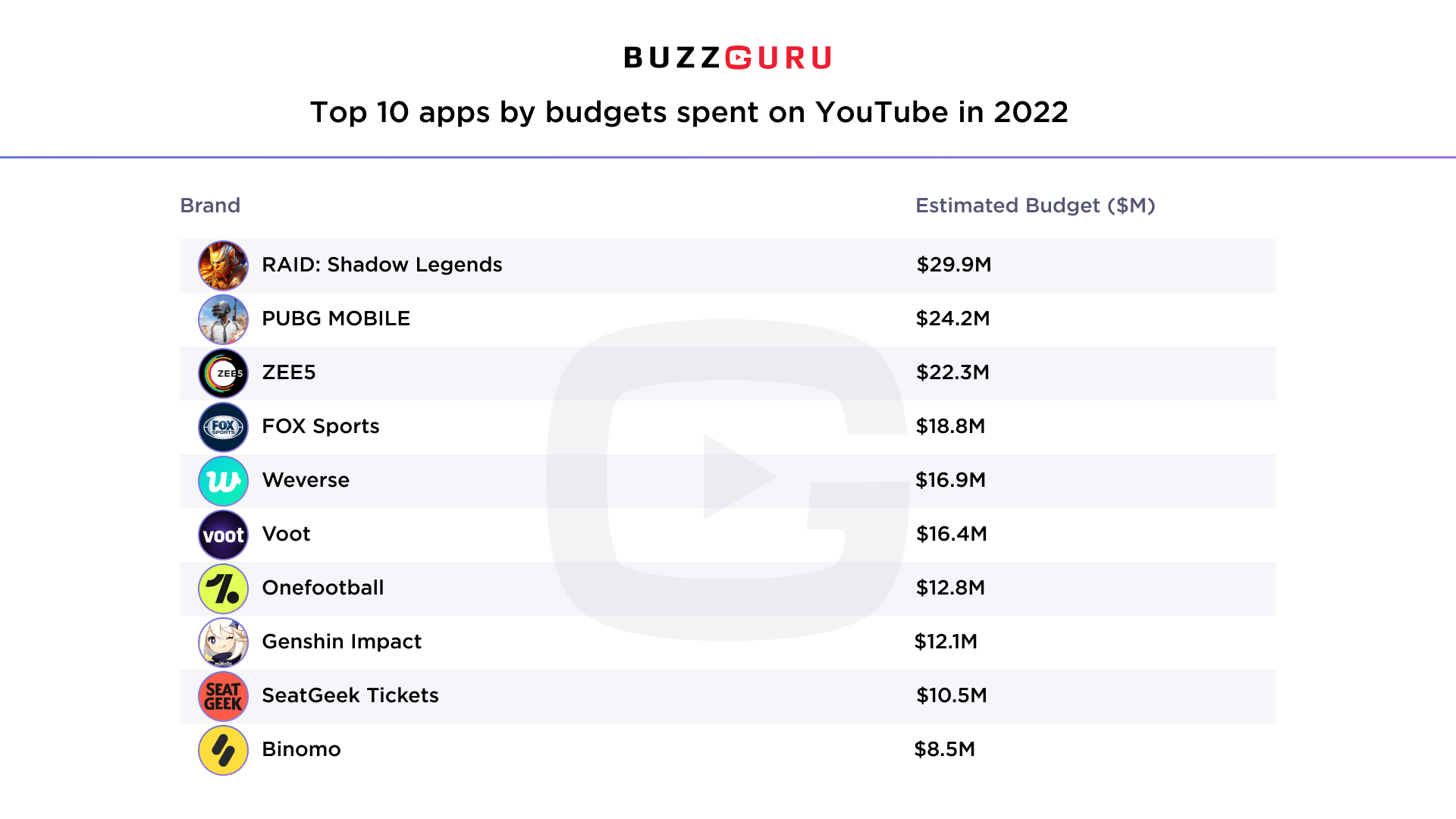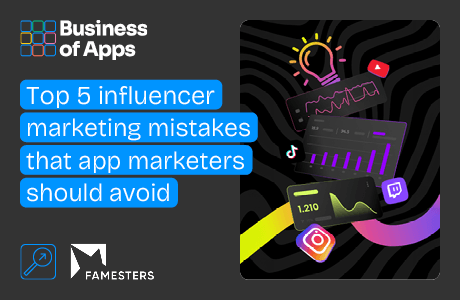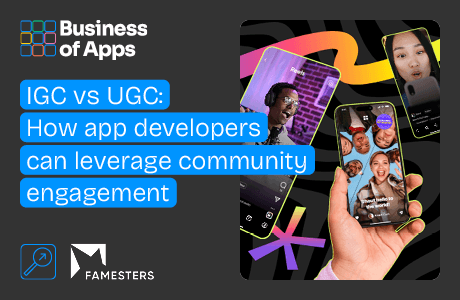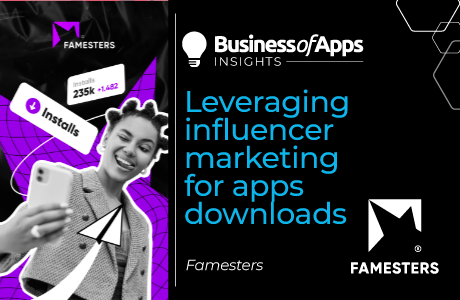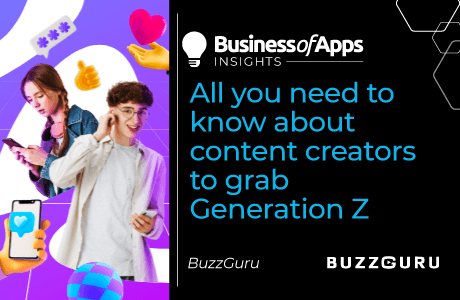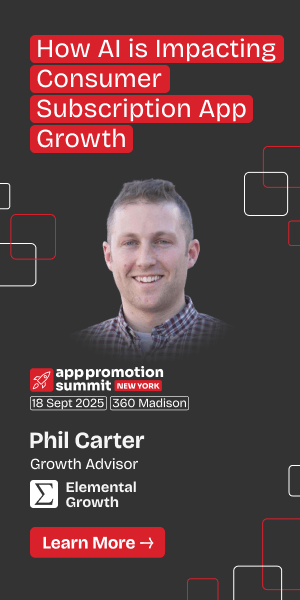The mobile app market is growing at an extremely fast pace: total revenue is expected to show an annual growth rate (CAGR 2022-2027) of 8.58%, resulting in a projected market volume of US$755.50B by 2027.
Mobile app market total revenue
Source: Statista
In this highly competitive industry, many app developers and marketers are constantly looking for new ways to build mobile app growth strategies that actually work. Having more than 6 years of experience in promoting apps through influencer marketing, Famesters has witnessed the rise of influencers as powerful mediators between app developers and their audiences.
Every year, brands allocate budgets to influencer marketing. Why? Influencers, with their curated content and trusted follower base, play a pivotal role in driving app downloads and fostering user engagement.
Influencer marketing spend in the US
Source: BuzzGuru
Furthermore, their unique ability to create relatable narratives around app features can significantly boost user engagement. Their followers often see them as peers or role models, making their recommendations more effective than traditional advertising: 92% of consumers trust influencers’ proposals. As a result, partnering with the right creators can be a game-changer for app developers and marketers aiming to elevate their brand’s presence and user retention in a saturated market.
Top 10 apps by budgets spent on YouTube in 2022
Source: BuzzGuru
The efficacy of influencer collaborations depends not only on influencers’ choice but also on the quality of the brief provided to them. A well-structured influencer brief acts as a roadmap, ensuring that the influencer’s content aligns with the brand’s objectives, messaging, and ethos. It provides clear directives on deliverables while still granting creative freedom, ensuring that promotional content is both authentic and effective. This leads to productive collaborations, maximizing the potential of influencer-driven campaigns.
However, measuring influencer marketing success can be challenging. At Famesters we understand the importance of showing value for money and bringing measurable results for business: not just growing brand awareness, but also attracting paying users, increasing app downloads, ROI, and other vital metrics. In this article, let’s dive into crucial metrics for app influencer marketing.
Daily active users (DAUs)
This metric refers to the number of unique users who open and interact with an app on a given day. It’s a metric commonly used to measure the engagement and health of an app’s user base: the more active users an app has on a daily basis, the more engaging and useful the app is perceived to be.
When launching an advertising campaign, we closely monitor this metric to gauge the effectiveness of our influencer marketing efforts: the number of users attracted. However, it’s not just about the initial count. A few weeks post-campaign, we take a look at DAU again to assess the quality of these new users. Why is it important? It allows for distinguishing between genuinely engaged audiences who show interest in the app and mere passive installations.
Empty installs refer to those when the app is downloaded but never opened. These installs provide valuable insight into the efficacy of the influencer marketing strategy. On one hand, they indicate that we’ve successfully captured the audience’s attention, encouraging them to download the app. On the other, the number of empty installs could signal a disconnect in our creative approach. While we’ve influenced the initial download, the creatives might not have been compelling enough to encourage actual registration.
For example, XYZ is a mobile puzzle game that has been experiencing a stagnant user base. In an effort to boost user engagement and gain new users, the developers partnered with a popular gaming influencer.
This Influencer has a YouTube channel with 3 million subscribers. On July 1st, he published a video playing XYZ showcasing its features and sharing a link to download the app.
DAU measurements:
- June 30th (Before the Campaign): XYZ’s DAU = 15,000 users
- July 1st (Day of Campaign Launch): XYZ’s DAU = 35,000 users
- July 2nd (Day After Campaign): XYZ’s DAU = 50,000 users
- July 10th (Ten Days After Campaign): XYZ’s DAU = 25,000 users
Analysis:
- On the day the influencer released the video, DAU for XYZ saw a significant jump from 15,000 to 35,000 users.
- The following day experienced an even bigger surge, possibly because more of the influencer’s subscribers viewed the video and subsequently downloaded and played the game.
- By July 10th, while the DAU had dropped, it still remained higher than the initial count before the influencer campaign. This suggests that while there was initial excitement, some of the new users continued to play the game, resulting in a net gain in active users.
User retention rate
After measuring DAU, we assess the retention rate next — the percentage of users who continue to use an app over a specific period of time after initially downloading it. It indicates how many users find your app valuable enough to keep using it versus those who abandon it.
This is the second most important metric for app influencer marketing. Essentially, it evaluates if our initial advertisement provided enough value to motivate the user to come back to the app and spend money. We can influence the User Retention Rate with our initial creative content by effectively showcasing the app’s value and reasons for users to return.
We can also boost retention by having additional ad campaigns. Instead of just one advertisement introducing the app, we could have multiple ad runs. For instance, an influencer might release another integration a week later, and then another two weeks after, to re-engage and remind the audience about the app’s advantages. So, the first advertisement might simply introduce the app and its benefits. Subsequent ads would remind users of the app and incorporate more information, highlighting the app’s value and the benefits of using it regularly.
Retention rate = (Number of users retained at the end of a period / Number of users at the start of that period) x 100%
For example, let’s calculate a 7-day retention rate:
- Day 1 (Campaign launch): XYZ App sees 5,000 new downloads attributed to the influencer promotion.
- Day 7 (One week after launch): Out of those 5,000 new users, 3,500 are still actively using XYZ App.
To calculate the 7-day retention rate:
Retention rate = (Number of users retained after 7 days / Number of users acquired on day 1) x 100% = (3,500 / 5,000) x 100% = 70%
Analysis:
- The 70% 7-day retention rate suggests that a significant majority of the users acquired through the influencer’s campaign found value in the XYZ App and continued to use it a week later.
- This high retention rate could indicate a successful alignment between the influencer’s audience and the target demographic of XYZ App. It might also suggest that the influencer effectively communicated the app’s benefits and features to their followers.
A high retention rate post-campaign indicates that the users acquired through the influencer find genuine value in the app, suggesting a successful influencer partnership. A low retention rate might indicate a mismatch between the influencer’s audience and your target demographic. It could suggest that while the content was compelling enough for users to download the app, the app itself might not have met their expectations.
Organic boost
The third important metric is the organic boost. In the context of influencer marketing, while you may directly acquire users from an influencer’s promotion (those who download the app right after seeing the influencer’s content), you’ll also notice an uptick in downloads from users who discover the app through other means, but as a secondary effect of the influencer’s promotion.
To quantify the organic boost from an influencer campaign, you can use the formula:
Organic boost factor (OBF) = (Total downloads – Direct paid downloads) / Direct paid downloads
For instance, if an influencer’s promotion directly resulted in 1,000 downloads, but you observed 2,500 total downloads during the campaign period, your OBF would be:
OBF = (2,500 – 1,000) / 1,000 = 1.5
This means for every download directly attributed to the influencer, you received an additional 1.5 downloads organically.
Obviously, as an agency, we measure the average level of organic users before launching a client’s campaign. After the launch, we look at how much this average has changed. We calculate the organic growth that resulted from our campaign.
As for campaigns in regions where it’s hard to determine an average organic growth due to constantly jumping activity, we can use the organic user coefficient that we calculated earlier. In cases where it’s difficult for the client to accurately track organic growth in a specific geographical area, we apply this coefficient. We multiply the number of direct installs by this coefficient to estimate the total number of installs, including organic ones.
Influencer marketing is a specific ad channel that provides a lot of organic traffic.
Customer lifetime value (LTV)
LTV, or Customer Lifetime Value, is probably the most important metric for all apps. It represents the estimated net revenue that a user generates for an app throughout their entire period of usage. It indicates how much value (usually monetary) a user brings to the app from the moment they download it until they stop using it.
At Famesters, we follow this metric to assess the quality of the acquired users and how well the advertising pays off. LTV is crucial in determining the return on investment (ROI) of your influencer campaigns. Furthermore, understanding LTV helps make informed decisions about how much to spend on influencer marketing. If you know a user’s LTV is $50, you can determine an appropriate acquisition cost that ensures profitability.
For influencer campaigns, here is how we count the LTV:
LTV (from influencer X) = (Average revenue per user acquired through influencer X) x (Average user lifespan for users from influencer X)
For instance, if users acquired through an influencer campaign spend an average of $10 per month on in-app purchases and tend to use the app for an average of 6 months:
LTV = $10 x 6 = $60
If the cost to acquire a user (CAC) from that influencer was $15, then the net value gained from each user is $45, making the campaign profitable.
Remember: LTV isn’t static. As you introduce new features, monetization methods, or other updates, user behavior and their value can change. Also, continuously monitor LTV and adjust your marketing strategies accordingly – this helps.
Consider running pilot campaigns with new influencers to gauge the LTV of their audiences before diving into more extensive collaborations.
Engage with influencers for feedback. They often have insights into their audience’s preferences and can provide suggestions to enhance user experiences and, by extension, LTV.
Cost per install (CPI) and cost per subscription (CPS)
In influencer marketing for apps, two other metrics to consider are CPI and CPS are often discussed in tandem because they provide a more holistic view of the campaign’s effectiveness, from user acquisition to user monetization.
When we work with an app that uses a subscription model, we initially examine the cost per install after an advertising campaign. This helps see if our install forecasts align with the actual results. But even if the CPI matches the expectations, issues might arise with the CPS.
For example, we might attract a sufficient number of installs, but if not enough of them convert to subscriptions, it can pose challenges for the ROI. In other words, while we may have plenty of installs if users aren’t purchasing subscriptions, they might not generate enough revenue for the client. Hence, the final key metric derived from CPS is the ROI.
Analyzing both CPI and CPS allows brands to fine-tune their influencer partnerships. For instance, if the CPI is low but CPS is high, it might indicate that while the influencer is driving downloads, the users might not see the app’s long-term value. Brands can use such insights to re-evaluate messaging, offers, or even their approach to the influencer partnership itself. Brands can also structure deals with influencers based on both metrics, offering a base payment for driving installs (CPI) and a bonus or commission for converting subscriptions (CPS).
Return on investment (ROI)
As we’ve discussed, CPI and CPS are foundational metrics in influencer marketing for apps. While these metrics illustrate the cost aspects of acquiring users and converting them into paying subscribers, they only paint half the picture. The other half? The returns these users bring to the app lead us to return on investment (ROI).
ROI quantifies the overall value generated from an investment relative to its cost. In the case of influencer marketing for apps, it captures the financial return from investing in influencer campaigns compared to the costs associated with these campaigns (like CPI and CPS).
The real magic of ROI is that it ties together these cost metrics (CPI and CPS) with the revenue generated from users, providing a more holistic view of the campaign’s success. Instead of merely focusing on costs, ROI allows marketers to understand the bigger picture: for every dollar spent on influencer marketing, how much is the app earning back? According to BuzzGuru research, 89% of marketers find ROI from influencer marketing comparable to or better than other channels.
ROI from influencer marketing
Source: BuzzGuru
The landscape of influencer marketing for apps is rich with opportunities, but its true potential can only be harnessed when backed by measurable results. Understanding and prioritizing the right metrics is like having a GPS in a vast digital forest; it guides your efforts, ensures your resources are well-spent, and helps refine your strategies over time. So, as you venture into the world of influencer marketing for your app, let these metrics be your North Star, leading you to fruitful collaborations and measurable results.
If you’re aiming to elevate your mobile app’s reach and tap into new audiences, leveraging influencer marketing is a promising avenue. At the Famesters agency, we bridge the gap between you and relevant creators, ensuring your app gains the spotlight it deserves. Just contact us and let’s chart a path to your app’s success together.



